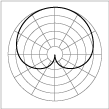|
Mixed-order Ambisonics
It is possible to define an Ambisonic signal set with non-uniform resolution depending on source direction. This practice is called mixed-order, and it has consequences for the layout and interpretation of files, streams, or physical connections in Ambisonic data exchange. As with all things Ambisonic, complexity has increased as research progressed, and the term has grown to include new concepts which were not anticipated when Ambisonics was first invented in the 1970s. When dealing with subsets of the multipole expansion, the base ordering of the components (according to whatever ordering scheme has been agreed on) is usually not changed. Instead, the unused components are simply left out, or, where bandwidth or space is not at a premium, zeroed. True Mixed-order schemes Horizontal-only Horizontal-only recordings or mixes are the most commonly encountered mixed-order signals, because the horizontal plane is by far the most likely location of musical or other performers, ... [...More Info...] [...Related Items...] OR: [Wikipedia] [Google] [Baidu] |
Ambisonic Reproduction Systems
The design of speaker systems for Ambisonic playback is governed by several constraints: * the desired spatial operating range (horizontal-only, hemispherical, full-sphere), * the predominant resolution (= Ambisonic order) of the expected program material, * the desired localisation performance and size of listening area versus the available number of speakers and amplification channels, and * the theoretically optimal distribution of speakers versus the actually available placement and/or rigging options. This page attempts to discuss the interaction of these constraints and their various trade-offs in theory and practice, as well as perceptional advantages or drawbacks of specific speaker layouts which have been observed in actual deployments. General considerations Near-field effect In its original formulation, Ambisonics assumed plane-wave sources for reproduction, which implies speakers that are infinitely far away. This assumption will lead to a pronounced bass boost fo ... [...More Info...] [...Related Items...] OR: [Wikipedia] [Google] [Baidu] |
Ambisonic Data Exchange Formats
Data exchange formats for Ambisonics have undergone radical changes since the early days of four-track magnetic tape. Researchers working on very high-order systems found no straightforward way to extend the traditional formats to suit their needs. Furthermore, there was no widely accepted formulation of spherical harmonics for acoustics, so one was borrowed from chemistry, quantum mechanics, computer graphics, or other fields, each of which had subtly different conventions. This led to an unfortunate proliferation of mutually incompatible ad hoc formats and much head-scratching. This page attempts to document the different existing formats, their rationales and history, for the terminally curious and those unfortunate enough to have to deal with them in detail. Most modern applications use ACN and SN3D, although ''traditional'' first order is still common. Spherical harmonics in Ambisonics A common formulation for spherical harmonics in the context of Ambisonics is : Y_\ell^m ... [...More Info...] [...Related Items...] OR: [Wikipedia] [Google] [Baidu] |
Spherical Harmonics Deg3
A sphere () is a geometrical object that is a three-dimensional analogue to a two-dimensional circle. A sphere is the set of points that are all at the same distance from a given point in three-dimensional space.. That given point is the centre of the sphere, and is the sphere's radius. The earliest known mentions of spheres appear in the work of the ancient Greek mathematicians. The sphere is a fundamental object in many fields of mathematics. Spheres and nearly-spherical shapes also appear in nature and industry. Bubbles such as soap bubbles take a spherical shape in equilibrium. The Earth is often approximated as a sphere in geography, and the celestial sphere is an important concept in astronomy. Manufactured items including pressure vessels and most curved mirrors and lenses are based on spheres. Spheres roll smoothly in any direction, so most balls used in sports and toys are spherical, as are ball bearings. Basic terminology As mentioned earlier is the sphere' ... [...More Info...] [...Related Items...] OR: [Wikipedia] [Google] [Baidu] |
Null (physics)
In physics a null is a point in a field where the field quantity is zero as the result of two or more opposing quantities completely cancelling each other. The field may be scalar, vector or tensor in nature. Common situations where nulls arise are in the polar patterns of microphones and antennae, and nulls caused by reflections of waves. Microphones A common polar pattern for microphones is the cardioid. This has a single direction in which the microphone does not respond to impinging sound waves. Highly directional (shotgun) microphones have more complex polar patterns. These microphones have a large, narrow lobe in the main direction of sound reception but also a smaller lobe in the opposite direction and usually also several other smaller lobes. This pattern is achieved by wave cancellation inside the body of the microphone. Between each of these lobes is a null direction where no sound at all is detected. Antennae {{main, null (radio) A common, and basic, radio ant ... [...More Info...] [...Related Items...] OR: [Wikipedia] [Google] [Baidu] |
Hemispherical Basis Deg5
A sphere () is a geometrical object that is a three-dimensional analogue to a two-dimensional circle. A sphere is the set of points that are all at the same distance from a given point in three-dimensional space.. That given point is the centre of the sphere, and is the sphere's radius. The earliest known mentions of spheres appear in the work of the ancient Greek mathematicians. The sphere is a fundamental object in many fields of mathematics. Spheres and nearly-spherical shapes also appear in nature and industry. Bubbles such as soap bubbles take a spherical shape in equilibrium. The Earth is often approximated as a sphere in geography, and the celestial sphere is an important concept in astronomy. Manufactured items including pressure vessels and most curved mirrors and lenses are based on spheres. Spheres roll smoothly in any direction, so most balls used in sports and toys are spherical, as are ball bearings. Basic terminology As mentioned earlier is the sphere' ... [...More Info...] [...Related Items...] OR: [Wikipedia] [Google] [Baidu] |
